As Rocks Behave Like Fluids
As curious generalists working across the divergent fields of the arts, ecology and futures, we were invited to explore existing and potential relationships between people and the desert in the North American Southwest, under the auspices of the Global Institute of Sustainability. With our colleagues from The Desert Humanities Initiative and the Center for Philosophical Technologies, we embarked on a three-year-long journey across the Sonoran and Mojave deserts as they are, as they were, and as they might be. Excerpts from the Dust and Shadow Fieldnotes.

Desert. A place of desiccated time, layered time, geological, vegetal, human time. Here, time kneads the Earth’s crust into deep folds, cracks, and canyons. The long, slow temporality of the desert is capable of sudden bursts of ecstatic action. Plants lay dormant through cycles of drought or grow slowly for centuries, bursting into blossom after the first rains. Briefly accelerating the experiential time of spiders, snakes, and cacti.
Humans come and go. Blown through the ages like tumbleweeds. Amid the nameless dust clouds and rocky outcrops, the social insects in their frantic mounds. The shy reptilian monsters and passive-aggressive cacti. The gloomy spirits of cell towers and brooding owls.
Things don’t really decay here. They shrivel, dry up, or slowly rust, yet remain present, as they gradually erode into dust. A thick, dusty atmosphere of things that were, things that are, and things that might be. Dust of places ground in the mill of time. Densities and intensities coagulating on a larger-than-human scale, illuminated by stark light or lurking in the deep shadow.
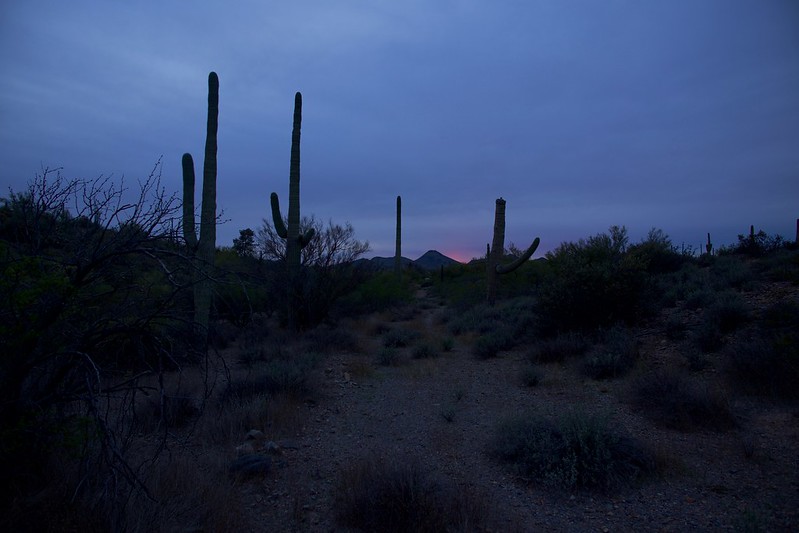
Our gradual attunement to the desert expanse, its climate, rhythms, and scales, became an experiment in communing rather than examining. An exploration of an embodied sense of layered time and material wonder. Being part of the world without romanticising wilderness or drawing hard distinctions between the desert and the cities within it.
An attunement at various speeds and human densities. Attuning to the smear of the landscape sliding past while driving, to the irregularities of the path while trail-running or hiking, to the sounds of the frosty ground and howling wind while walking. The spatial and temporal scales in the desert show themselves differently when experienced at speed.

What began as a pale green plateau splits into dark jagged lines. A crack in the earth. The crack widens into a gorge and deepens into ravines. It splits open the landscape until the horizontal plateau disappears into the vertical crags of raw rock face. Geological scar tissue as monument to the violent, persistent forces shaping the earth. Echoes of an era before the planet became hospitable to humans. Reminders not to take the Earth’s hospitality for granted.
Driving through the desert is like watching a slow movie of geological magnitude. We turned north, driving past a gentler geological process — layered sedimentation of rock and sand and ash. Reds, pinks, yellows, purples interspersed with gradients of dusty grey, black, and white. The dust of minerals layered with the dust of forests and crushed bones. From afar the hills appear liquid, coloured with inks and turbulent water. A time scale in which rocks behave like fluids. Layered time of fossilised erosion.
What might the thin layer of the Anthropocene look like, when sedimented atop those older layers, with hues of non-compostable plastics and industrial waste? What layers will come next? What will cover the remnants of the human-dominated sliver of deep geological time?
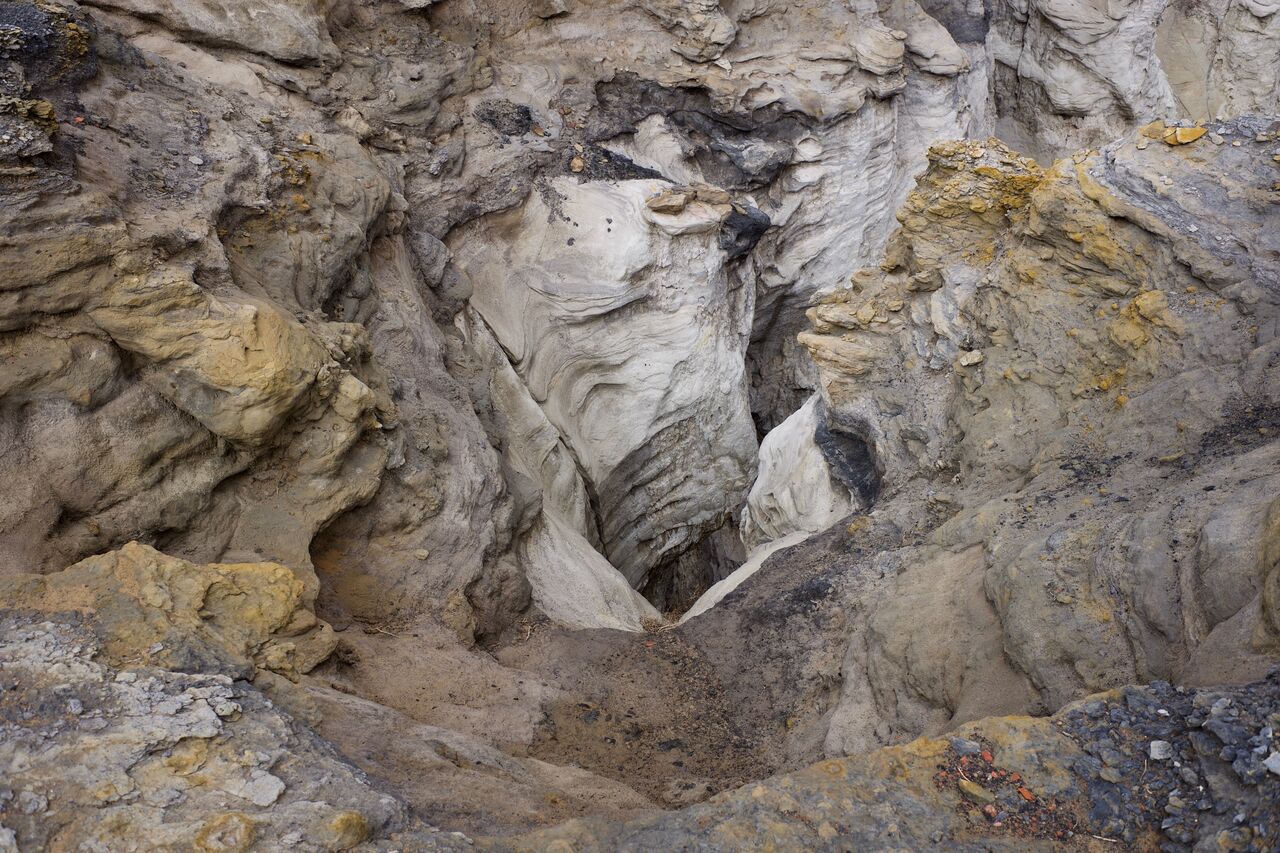
When we stopped, the parking lot was busy enough for time’s acceleration to the speed of gnats and twitching selfie sticks. We were attuning to an Insta-desert in which moments of awe are carefully mediated. Attuning to digital mediation of landscapes framed at screen resolution. The experience validated by digital devices and prescribed perspectives. An attunement to the rhythms of desert tourism.
Uncanny shafts of light were framed by smooth undulating rocks that guided our gaze as we scuffled along in hazy shadows. Thick drifts of dust stirred up by thousands of feet. The perspective changed with occasional flickers of iron ore-coloured light, opening upwards into cavernous formations. Looking up, we could have been in the womb of the planet, all red and warm and smooth. Looking around, reds turned into dusty browns, pinks, and ochres of human faces. Some bewildered, some quietly overwhelmed, others indifferent and impatient.
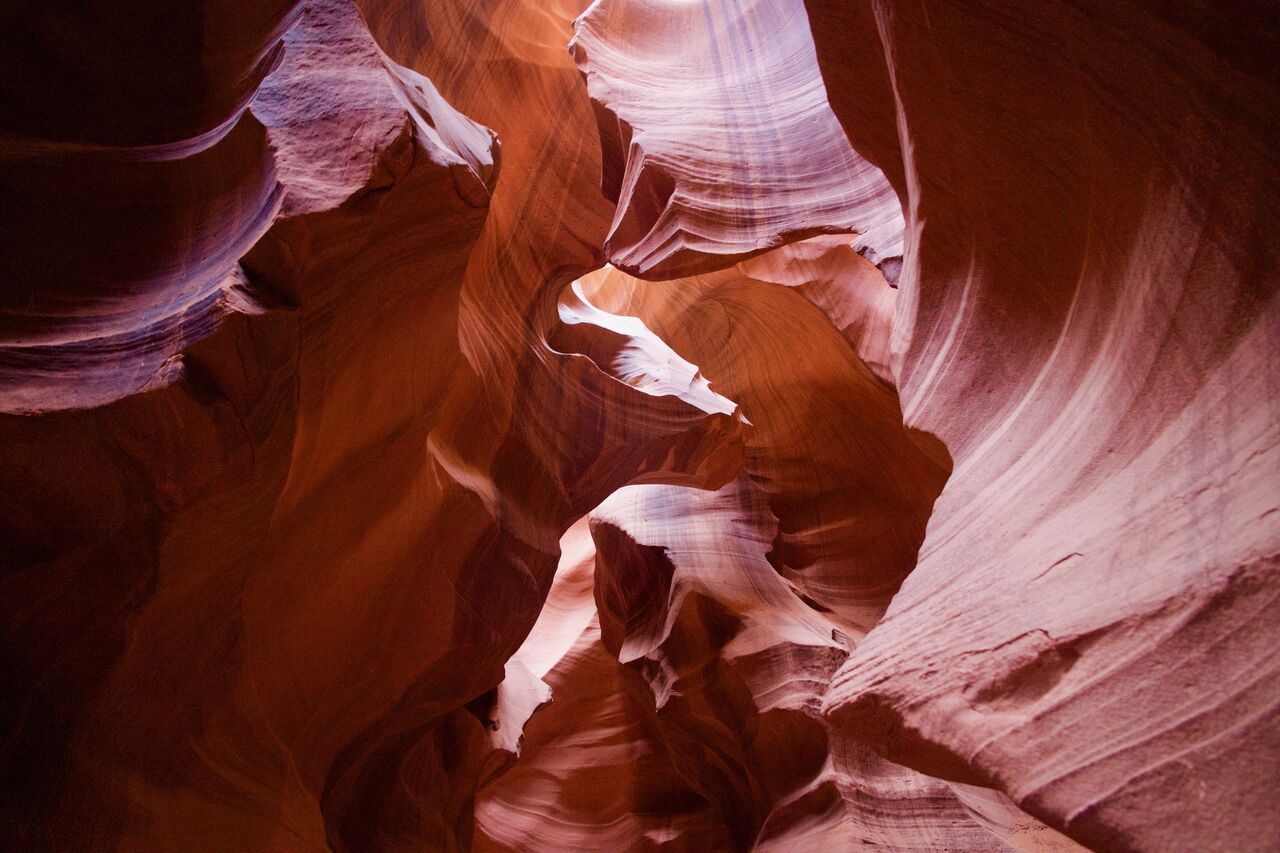
The desert chirps and rattles and murmurs, punctuated every few minutes by the roar of an airplane overhead, buffeting the chatter of birds, the cracking of wood, or an argument between unseen humans. The effortless, unperturbed, lithic existence of the planet present in its apparent stillness.
We slid and slipped towards an empty riverbed, holding onto gnarly bristlecone pines. Their bark twisted and turned around the trunks, textured in convoluted alien scripture and secure handholds. Above our heads the wind played the needles and dry branches. To these otherworldly instruments we added a rhythm section, crunching frost and squelching sludge under our feet.

At the bottom of the trail, the wind stopped. Silence began creeping back into an already sparse soundscape. A drop of water. A solitary crow. A tiny crack or slide of a sleepy mountain. And then, the inevitable noise of humanity returned. The loud voices of jets. Trail runners. A particularly asthmatic motorbike in the distance soloing above the spluttering orchestra of ringtones. The invisible smog of noise pollution hovering over the still places, cloudlike.
We travelled onwards as clouds loomed on the horizon. Storm clouds. Dust clouds. Clouds of invisible pollution. What appeared as pristine desert could harbour an atmosphere filled with airborne toxic dust and deadly groundwater. Attuning to this landscape gave rise to a visceral sense of unease, displacement, halting conversations, prolonged awkward silences and the hollow taste of unseen dread, skewed injustices.

The next morning, the clouds parted and temperature rose. We continued our deceleration from 5000 miles in a day, 1000 miles in a week to one mile in 10 days. From Belgium to Arizona, from FoAM to Arizona State University. We arrived and we stayed put. We listened. Experiencing the desert at 0 mph, as the warm light of the afternoon intensified into a blood-hued sunset, then faded into cool shades of dusk, until the pinprick starlights began blinking into existence, scattered across the desert sky.

The longer we remained still, the more frequently our neighbours visited. Hummingbirds, lizards, insects, crows, a pack of coyotes, deer, javelina, even a solitary shapeshifter. The nocturnal scuttlings of unseen beasts. The brutal nonchalance of bats eating crickets. A mundane spectacle of the everyday, indifferent to our arrival. Amidst this teeming habitat on the edge of urbanity, we began eavesdropping on the incomprehensible conversations of animate matter. Dust and cacti, trees and insects, concrete and sunlight. What could their voices tell us about the place? What technologies could provide a way of communicating (or communing) within the narrow band of human awareness? What would those technologies look like that could help us attune to our surroundings, rather than distracting us from them? How could we help ourselves listen to the entities we share the planet with?
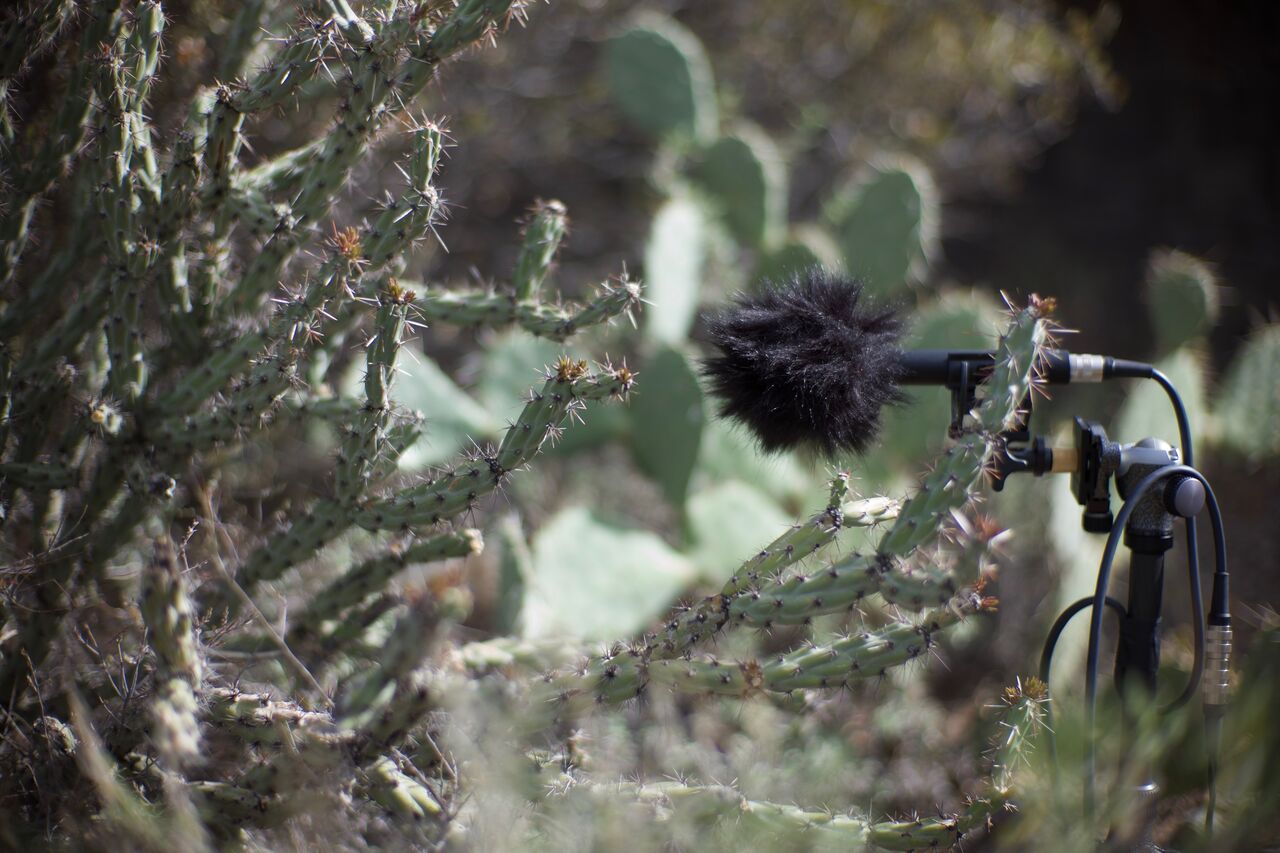
It is not enough to fight for the land; it is even more important to enjoy it. While you can. While it’s still here. So get out there and hunt and fish and mess around with your friends, ramble out yonder and explore the forests, climb the mountains, bag the peaks, run the rivers, breathe deep of that yet sweet and lucid air, sit quietly for a while and contemplate the precious stillness, the lovely, mysterious, and awesome space. —Edward Abbey
We crossed the threshold into the park, a dim tunnel under a busy highway, decelerated, listening. Walking slowly, in single file. Waiting for each step to find its footing, as the senses become engaged with traversing inner and outer landscapes, simultaneously. We traced the edges of the city and the desert, attuning to their complex rhythms and relationships. Rhythms above and below, sharp interludes. Along a path beset by the spectre of an abandoned railroad, hollow and dusty. Snaking along a resonant ridge haunted by jet engines in the wind. Climbing through an outcrop of boulders, hearing the rustling of sparse undergrowth. Aswarm with critters signalling.
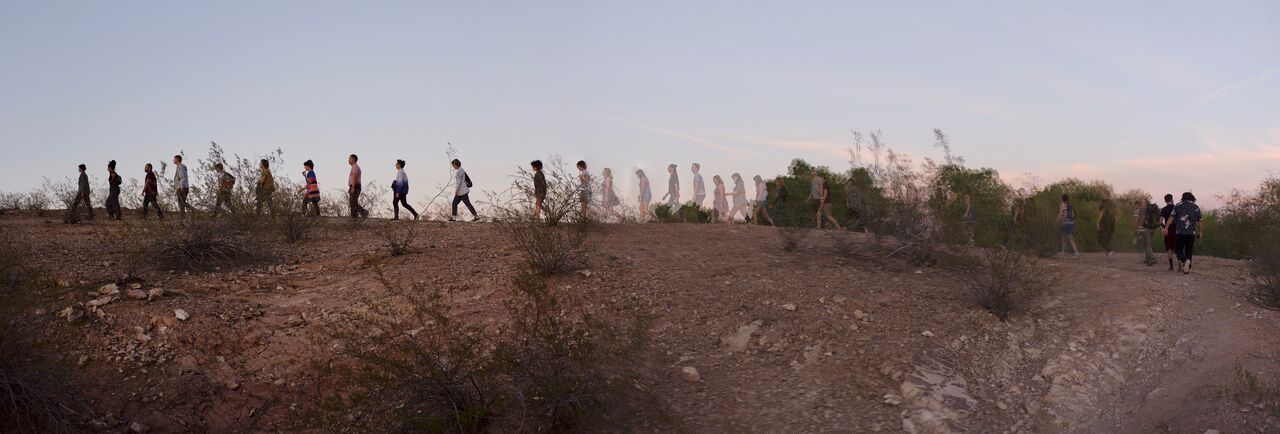
Absorbing the desert expanse at dusk, in The Silence of the Cacti. A gentle turn revealing urban soundscapes of civilisation in collapse. Hushed darkness cut through the eerie river of tail lights. A descent, into the dripping, budding, and chirping of early spring. The hollow dryness of a rustling desert, gradually receding into the night with unseen others, uncanny and quiet. We let our minds wander, spinning new yarns, possible lives lived otherwise. Of vapour trails writing their poetry in the colours of sunset.Instructions for a self-guided soundwalk
dust & shadow redux from foam on Vimeo.
Attuning to the Desert
Carry water. Wear good shoes. No drones.
Adjust your rhythm to the desert. Emphasize slowness and short bursts of activity.
Move at different speeds. Notice how your body adapts to the lay of the land.
Stay still. Practice durational abiding to sense other-than-human scales.
Listen. Use your ears, skin, and sensing technologies to hear voices often unheard.
Become comfortable with solitude. Learn from shamans and desert hermits.
Acknowledge interdependence. Live in solidarity with other desert inhabitants.
Celebrate life. Hold seasonal observances, ceremonies, and feasts.
Commune. Across cultures, species, and environments.
Remember — the desert is awe-inspiring; it is also unforgiving.

❧